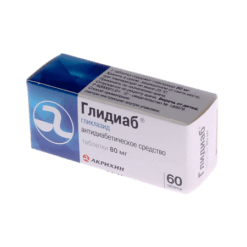No products in the cart.
Glimepiride Canon, tablets 1 mg 30 pcs
€1.00
Out of stock
(E-mail when Stock is available)
Description
Glimepiride Canon is a hypoglycemic drug for oral use – a sulfonylurea derivative of new (third) generation. Glimepiride Canon acts mainly by stimulating secretion and release of insulin from beta-cells of the pancreas (pancreatic action). As with other sulfonylurea derivatives, this effect is based on increasing the response of pancreatic beta cells to physiological glucose stimulation, and the amount of insulin secreted is significantly lower than that of traditional drugs – sulfonylurea derivatives.
The least stimulating effect of glimepiride on insulin secretion also provides a lower risk of hypoglycemia. In addition, glimepiride has extrapancreatic action – the ability to improve the sensitivity of peripheral tissues (muscle, fat) to the action of its own insulin, reduce insulin uptake by the liver; it inhibits the production of glucose in the liver.
Glimepiride Canon selectively inhibits cyclooxygenase and reduces the conversion of arachidonic acid to thromboxane A2, which promotes platelet aggregation, thus having an antithrombotic effect.
Glimepiride Canon promotes normalization of lipids, reduces the level of malondialdehyde in blood, which leads to a significant decrease in lipid peroxidation, this promotes the antiatherogenic effect of the drug.
Glimepiride Canon increases the level of endogenous α-tocopherol, catalase activity, glutathione peroxidase and superoxide dismutase that helps to decrease the severity of oxidative stress in the patient’s body which is constantly present in type 2 diabetes.
Indications
Indications
Diabetes mellitus type 2.
Active ingredient
Active ingredient
Composition
Composition
Active substance:
glimepiride 1 mg;
Ancillary substances:
Lactose monohydrate;
Corn starch;
Sodium carboxymethyl starch;
povidone;
polysorbate;
talk;
magnesium stearate;
iron dye (E 172)
How to take, the dosage
How to take, the dosage
The initial and maintenance dosage is established individually on the basis of the results of regular monitoring of blood and urine glucose levels.
The initial dose is 1 mg once daily. If necessary, the daily dose may be gradually increased (by 1 mg over 1-2 weeks) to 4-6 mg.
The maximum dose is 8 mg/day.
Interaction
Interaction
Increased hypoglycemic effect of glimepiride is possible with concomitant use with insulin or other hypoglycemic drugs, ACE inhibitors, allopurinol, anabolic steroids and male sex hormones, chloramphenicol, coumarin derivatives, cyclophosphamide, disopyramide, fenfluramine, pheniramidol, fibrates, fluoxetine, guanethidine, isophosphamides, MAO inhibitors, miconazole, PASC, pentoxifylline (when injected in high doses), phenylbutazone, azapropazone, oxyphenbutazone, probenecid, quinolones, salicylates, sulfinpyrazone, sulfonamides, tetracyclines.
. Weakening of the hypoglycemic effect of glimepiride is possible with concomitant use with acetazolamide, barbiturates, corticosteroids, diazoxide, diuretics, epinephrine (adrenaline) and other sympathomimetics, glucagon, laxatives (after long-term use), nicotinic acid (in high doses), estrogens and progestogens, phenothiazine, phenytoin, rifampicin, thyroid hormones.
When used concomitantly, histamine H2-receptor blockers, clonidine and reserpine can both potentiate and decrease the hypoglycemic effects of glimepiride.
The effects of coumarin derivatives may be enhanced or weakened with glimepiride.
Ethanol may increase or decrease the hypoglycemic effect of glimepiride.
Contraindications
Contraindications
Hypersensitivity, type 1 diabetes, diabetic ketoacidosis, diabetic precoma and coma, severe hepatic and renal dysfunction, leukopenia, pregnancy, lactation.
Side effects
Side effects
Cardiovascular system and blood (hematopoiesis, hemostasis): rarely – BP decrease, thrombocytopenia, leukopenia, granulocytopenia, agranulocytosis, erythropenia, pancytopenia, hemolytic and aplastic anemia.
Nervous system and sensory organs: dizziness, headache, transient visual impairment.
Gastrointestinal system disorders: nausea, vomiting, abdominal pain, feeling of heaviness in the epigastric region, diarrhea, intrahepatic cholestasis.
Metabolism disorders: hypoglycemia.
Others: increase in transaminases, hyponatremia, skin allergic reactions, cutaneous porphyria, asthenia; rarely – shortness of breath, hepatitis, allergic vasculitis, photosensitization.
Overdose
Overdose
Symptoms: hypoglycemia (nausea, vomiting and epigastric pain, restlessness, tremors, visual disturbances, coordination disorders, drowsiness, coma and seizures).
Treatment: if the patient is conscious – induction of vomiting, plenty of fluids, activated charcoal and laxatives. In case of severe overdose – intravenous bolus injection of dextrose solution (50 ml of 40% solution), then – infusion of 10% solution. Continuous monitoring of the patient, maintenance of vital functions and blood glucose concentration control are necessary (recurrent episodes of hypoglycemia are possible). Further treatment is symptomatic.
Similarities
Similarities
Additional information
| Shelf life | 5 years |
|---|---|
| Conditions of storage | In a light-protected place at a temperature not exceeding 25 °C, in a tightly closed container. |
| Manufacturer | Kanonfarma Production ZAO, Russia |
| Medication form | pills |
| Brand | Kanonfarma Production ZAO |
Related products
Buy Glimepiride Canon, tablets 1 mg 30 pcs with delivery to USA, UK, Europe and over 120 other countries.














